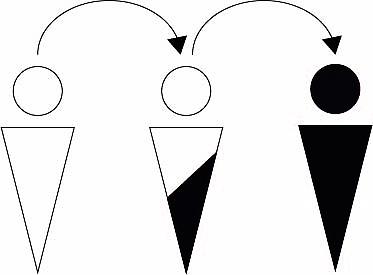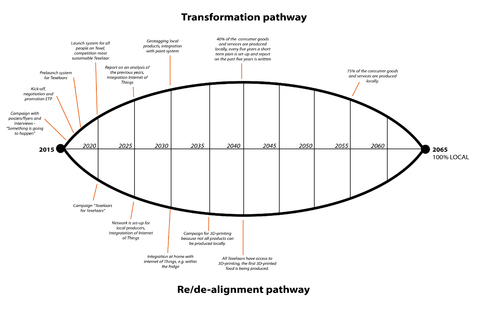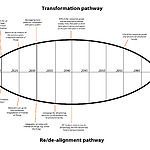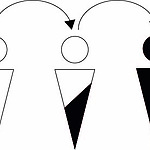As described in previous paragraphs the Planet Local and Profit Local are both ends of a spectrum wherefore this report designs. Following this, two distinct pathways are set out. Both strive for the same goal; A sustainable lifestyle in 2065 wherein people choose for green options, as well consciously as unconsciously. To reach this goal of a self-sufficient Texel, it's necessary to make a change in the socio-technical system. Change is not easily made and, even when it happens, it is difficult to stick to this transition and not steer back to the old situation again. Literature shows that change is positively influenced when cooperation and interaction are targets. This is kept in mind using the technological solutions considered in paragraph 4.2. Besides, since 50 years is a long period, milestones are set up at several points along the pathway.
In sum, both pathways show complex governance arrangements which are very different from each other. They are explained by the course of the driving force behind the transformation, how this change is influenced and why this is accepted.
Pathway 1. Transformational Pathway
The first specified pathway has similarities with the transformation pathway as it was discussed in paragraph 4.1. It focuses on the short-term and hedonistic approach that raises awareness of the profit locals first. Since this group is assumed to be more stubborn and set in their old ways than the early adopters, they are therefore not easily intrinsically motivated. This pathway thus needs a focus on economic instruments to steer towards the desired direction of a sustainable lifestyle 2065. This group needs action that is pushed from outside in such a way that it eventually will become their intrinsic motivation and action.
HOW and WHAT?
As mentioned, we believe that the roadmap to a more sustainable lifestyle is highly connected to financial incentives that are given to consumers. However, before we can stimulate the consumption of locally produced sustainable products, which has to do with market based economic instruments, we have to overcome the dominant regime on consuming non-sustainable products and services which is standard in the lifestyle of the local profit.
However as Westley et al puts it: ‘Current institutional arrangements, including the lack of incentives for the private sector to innovate for sustainability, and the lags inherent in the path dependent nature of innovation, contribute to lock-in..’ (Westley, et al., 2011). In their description of possible pathways of transformation, they formulate a way to ‘unfreeze’ the current locked-in regime and stimulate a ‘disruptive’ innovative regime. ‘Tax incentives, subsidies, and competitions or challenges’ are possible ways to stimulate the regime changes via both network and hierarchy.
However due to legal restrictions the municipality is not allowed to raise higher taxes on non sustainable products or to give direct subsidiaries to locally produced sustainable products. We see however an opening to grant a certain incentive to the consumers of locally produced product via a point-awarding system comparable to the Bonuskaart or Airmiles card. These incentive systems have proven to be very successful in The Netherlands. Research stated that 95% of all Dutch households participates with at least one incentive system (Leenheer, 2006) and that it positively contributes to the sales volumes and profit. In the case of a more sustainable Texel, we could make use of such an incentive program in order to stimulate the locally produced goods and services.
Currently there is already a label that is used to distinguish local products and that is called Echt Texels Product (ETP) (Echt Texels Product, 2015). This label has been used for 30 years now and products with the ETP-label find at least 75% of their resources on Texel. However ETP products are considered in the current dominant regime of the profit locals to be too expensive.
Therefore, we want to ‘lower the thresholds between regimes’ by financially stimulating the consumption of EPT products and incorporate the EPT incentive program on the island of Texel that is not only targeted at the tourists but also at the local consumers.
We introduce a ETP-RFID tag that will be placed on all ETP-label-goods, but is then digitally readable by all smartphones. We use the RFID tag in order to prevent false copies of this tag and to deliver a smooth processing of this incentive system. Consumers can scan their products in a ETP app and then collecting ETP-points for each product. Non physical products or services (like locally generated electricity) are given a unique QR-code.
With these points several (sponsored) products or sustainable services can be bought. For instance:
For the locals: Reduction or free rides on the TESO boat
Reduction or free rides on the local public transport system
Reduction on locally produced products
Reduction on the locally produced energy
For the tourist: Reduction or free entrance to local museums or parks.
Reduction on locally produced products
Reduction or free rides on the local public transport system
How is the change influenced?
In order to achieve a regime change the ETP-labelled products have to be at least comparable or cheaper than their non-EPT counterpart. To create this price equality or difference, local producers have to increase their production so large scale production benefits can be compounded with the current prices. In this way the ETP products will become more affordable and thus consumed more by locals and tourists. The incentive program has to stimulate this growth. A second advantage of this system is that it stimulates the local economy and local employment.
A third possible advantage is that this system could be connected to a future geotagging chip that enables the consumers to find out the place of of origin of a certain good. This system can than also be connected to the incentive program. For instance goods that are produced in direct vicinity of the consumer will be more rewarded than the products that are produced further away.
Why is it accepted?
First of all, the gap between the current sub-system and the future one, like we created, should also be agreed by the Texelaars. If they see the transition towards a sustainable lifestyle as a common goal, it is up to all of them to work on that together in the interest of the other Texelaars. This is, as Borras & Edler mentioned, important since change is not only about political institutions alone, but has to do with a total interplay of both societal and state actors (2014, p. 13). The economical hierarchy tool, the tax on undesired behaviour, deals with commanding and controlling and this can have some resistance from other societal groups who are not involved in the ETPs. This obtains for the subsidy for innovation were lack of transparency could emerge - on the contrary, since this subsidy has to start once it covers discussion and negotiation and since local products are advertised locals are sooner willing to help. They have their benefits in it too.
Pathway planning
This first pathway is set out in an overview wherein the earlier proposed incentives are listed (also see the visualization of the pathways). Not every single step will immediately lead to a more sustainable lifestyle and/or environment, since it should be noted that the existing patterns are not easy to break. But in the end, all the parts will supplement each other. ( see the figure visualisation of the pathways)
2016 - Since this transition is about short-term stimulants, the project starts immediately. To create more awareness about the plans we came up with, a general local sustainable campaign will start with posters and flyers throughout the city. Interviews on the streets will be done too in such way the Texelaars has the feeling something is going to happen. This makes them curious and their duration of engagement will grow.
2017 - The transition pathway will be, in negotiation with the Texelaars, set-up and the system will kick off. During this negotiation the Texelaar network can implement new ideas and/or come up with satisfactory outcomes. Every step made, every decision taken, will be explained to all the locals via email/posters etc. Besides, the ETP will be promoted extensively.
2018 - Prelaunch the system for Texel locals. When other societal groups keep on resisting, which is possible given the hierarchy, short term and hedonistic advantages should be showed.
2020 - Launch of the system for all people of Texel whereby the local products will get cheaper than the others. Launch of a competition for most sustainable Texelaar via the point system.
2025 - Integration with Internet of Things / programmed ordering. The past five years will be analyzed too. A report will be made. Do the products, promoted in 2017, indeed have larger bedding than before. And is it possible to meet supply and demand?
2030 - Local producers are equipped with geotagging sensors that measure the distance between producer and consumer. The less distance, the higher the points are awarded. This will be used for all products and services (so not only for food).
2040 - 40% of all consumed goods and services are produced locally - every five years a short term plan will be written and the previous five years will be analyzed.
2055 - 75% of all consumed goods and services are produced locally
2065 - 100% of all consumed goods and services are produced locally
Pathway 2. Re/de-alignment Pathway
Secondly, the other pathway raises the awareness of Planet Locals and has similarities with the de/re-alignment pathway discussed in the literature in paragraph 4.1 which is a rather radical pathway. Since the focus is more on the early adopters, planet locals, this pathway can therefore have a more eudaimonic approach with communicative instruments. After awareness is raised about practical applications of sustainability with focus on social interactions, actions from inside out are made, followed by the spread of enthusiasm towards other groups.
HOW and WHAT?
The roadmap to a sustainable lifestyle is based on communicative instruments to reach the planet locals. They are the early adopters who will need less stimulation compared to the more conservative profit locals. Social media is trending these days, it is assumed this will increase the coming years. Thus, social media will play a key-role in this pathway. Besides, the society can be thrown in a period of experimentation. This means that the daily life suddenly will change a lot. The difference with the previous pathway lies in the approach that starts with the local products itself immediately in combination with such an experimental period.
In short, as mentioned partly in chapter 4.3 too, this re/de-alignment pathway connects people with products via the internet of things too. But in this system the producers, consumers and their goods are immediatly linked and will slowly replace the supermarket. Raising price tags aren’t the solution in this case. This pathway involves major restructuring and is about niche experimentation, strong external developments like 3D printing of food will have big influences in such way ones lifestyle concerning food with all its interactions with the who (:supermarkets and producers) will change, supported with new services and facilities.
How is the change influenced?
Since this pathway is about re/de-alignment, and experiments are linked to that, the perspective of many people concerning food and local products will be influenced. It is assumed that the people, via this pathway, are intrinsically motivated; they simply want to have sustainable things. Throughout the years information for behavior change should be given, since the system works with hierarchy tools in a communicative system. This increases the transparency of the market too. The early adopters inspire in such a way the conservative profit local ones - as we described them. Since not everyone is connected yet, this can be done via the internet of things wherein needs and supply will be more clear to each other - products are not just there in the supermarket but, in the end, come to you via the local producers.
Why is it accepted?
The pathway that comes with sudden changes has probably less support at first than the previous pathway which has a lot to do with short term hedonistic transformations. We assume the interplay will have large backing after periods of experiments. Failure can appear more easily, resistance of groups can play a role or society can get suddenly more complex. But, results of sudden changes, even for a short period of time, can create major support too. Hereby it is important to analyse previous periods of short or long term experiments. Negotiation takes, thus, place afterwards.
The pathway planning
The second pathway is set out in an overview wherein the earlier proposed incentives are listed (also see the visualization of the pathways). The steps are bigger than the steps in the previous pathway, and more intensive periods of experimentation will be set up. Since lifestyle change is not a linear one-way path, but one which is very complex these milestone are example steps to make. During these steps we assume other sustainable changes will appear too and that an exchange of knowledge and interest will take place.
2020 - Campaign for local food via social marketing called Texelaars for Texelaars. This will use the nationalistic and proud attitude of the Texelaars. The short term goal hereby is to increase awareness about the existing local products. This is a starting point for the bigger upcoming program. Besides, a small research group with Texelaars included investigates the possibilities of a wider implementation of Internet of things.
2025 - Next, a network/program will be set up for local producers that has to do with internet of things. This will synchronizing performance with both products and consumers. Besides, a test period will take place with a small group op people in several towns throughout Texel and has to do with the home integration (e.g. fridge) with internet of things. Short term actions and reactions will be noted. The testperiod takes about 6 months. Afterwards, analysis will be made in order to find out advantages and disadvantages. This will be presented in newspapers and in social media. Lifestyles won't change immediatly but inhabitants can influence each other a lot.
2030 - After five years, total home integration (e.g. fridge) with internet of things will take place - Example: compared with 2005 almost no-one had a smartphone, nowadays we can't live without. We strive for the same changes with Internet of things. Slowely lifestyles are going to change.
2035 - Promoting campaign, since not every local product is available so the 3D printing, more widely known by then, will be promoted i.e. with subsidy which causes, as a network tool, that these interests are in public hands.
2040 - Everyone has a 3D printing possibility so the first 3D printed food will be examined. It is clear to us that this step cannot be literally predicted, but in striving for this as a goal it can enhance decision making in steps before.
2065 - 100% local food via autonomous transport and internet of things
See the figure below for a visualisation of both pathways:



